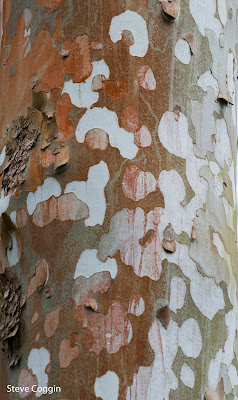 |
| Flowering Dogwood bark looks like alligator hide. Rowan County, North Carolina. |
The title
for this blog is the answer to a bad riddle.
Here it goes. “How do you tell a
Dogwood tree?” “By its bark”. Get it?
By its bark. I know, it is a bad
riddle.
For most of the year, you can identify trees by leaves, flowers and fruits. But in the winter, bark is one few clues we have for tree ID. Bark’s main job is to provide a waterproof protective layer for trees, shrubs and woody vines. The outermost layer of bark is called cork. Cork Oak, Quercus suber, a tree that grows around the Mediterranean basin, produces abundant cork. This cork is used to stopper wine bottles. The Southeastern United States has many trees with interesting and diagnostic bark.
Flowering Dogwood (Cornus florida) is a small tree native to Eastern North American forests. In early spring, Dogwood produces its familiar four bracted flowers that fill the woods with clouds of white. The flowers develop into red berries in autumn and are the favorite food of many migrating birds. Dogwood bark is gray with small rectangular plates that give the tree the appearance of alligator hide. So yes, you can tell a Dogwood by its bark.
 |
| Shortleaf Pine (Pinus echinata) bark is arranged in large plates. Rowan County, North Carolina. |
 |
| Loblolly pine (Pinus taeda) with the outer layers of bark scorched by fire. Rowan County, North Carolina. |
Many pines (Pinus sp.) are adapted to live in
environments with frequent fires and the bark is part of that adaptation. Pine bark is dark brown, thick and scaly. The bark is arranged in large plates that
help make the tree fireproof. A
low ground fire will burn off the outer bark scales but allow the tree to
survive.
 |
| American Sycamore (Platanus occidentalis) bark. Rowan County, North Carolina. |
American Sycamore (Platanus occidentalis) has light bark mottled with red, brown, gray and white patches. The light bark color makes these trees glow in the winter woods. As American Sycamore ages the bark on the lower parts of the trunk becomes scaly and peeling.
 |
| This hollow American Sycamore is a townhouse for Gray Squirrels (Sciurus carolinensis). They are peeking out from upstairs and down. |
Another
tree with peeling bark is River Birch (Betula
nigra). Paper-thin strips of bark
slough off the trunks of this wetland tree. A related species Betula papyrifera, Paper Birch, grows in the Northeastern United
States and Canada. Northern Indian
tribes used the bark of this tree to make their iconic birch bark canoes.
 |
| River Birch (Betula nigra) has peeling bark. Mecklenburg, County, North Carolina. |
I think American
Beech (Fagus grandifolia) has the
most beautiful bark in our area. The
bark is clean, smooth and mottled light gray.
Being so smooth makes American Beech a favorite tree for carving initials and declaring undying love.
 |
| American Beech (Fagus grandifolia) has smooth, gray bark. Rowan County, North Carolina. |
 |
| American Beech bark with carved graffiti. Rowan County, North Carolina. |
Shagbark
Hickory (Carya ovata) really does
have shaggy bark. As you walk through the woods, you can see long strips of
gray bark hanging from the trunks of mature trees. Native Americans used Shagbark Hickory bark to
make sugar and medicines.
 |
| Shagbark Hickory (Carya ovata) and its shaggy bark. Rowan County, North Carolina. |
Northern
Hackberry (Celtis occidentalis) has
interesting bark. On the lower sections
of the trunk, the bark makes ridges, nay even cordilleras, of cork. Upper
branches of the tree lack these odd ornaments.
This tree hosts the caterpillar of the Hackberry Emperor
Butterfly Asterocampa celtis.
 |
| Northern Hackberry (Celtis occidentalis) with corky growths on its bark. Rowan County, North Carolina. |
 |
| Closeup of Northern Hackberry cork ridges. Rowan County, North Carolina. |
 |
| Hackberry Emperor (Asterocampa celtis) caterpillars develop on Northern Hackberry. Mecklenburg County, North Carolina. |
Winged Elm
(Ulmus alata) gets its common name
from the extensive wings of cork on the stems. The bark proliferates on each side of a
branch to make the wings. Another tree
that makes cork wings on its stem is Sweetgum (Liquidambar styraciflua). The function of the winged stems of these two
trees is unknown.
 |
| Winged Elm (Ulmus elata) branch with cork wings. Rowan County, North Carolina. |
 |
| Stem of Sweetgum (Liquidamber styraciflua) with its winged stem. Rowan County, North Carolina. |
The final
example of interesting bark is a ringer from the tropics. Eucalyptus deglupta, Rainbow Gum, is a rainforest tree from the
islands of the Southwest Pacific. The
bark of this tree has stripes of red, green, orange and blue. Outside its natural range, Rainbow Gum is a
horticultural tree grown in warm climates from the American tropics to South
Florida, Texas and California. We found
this one, with is colorful bark, at the Fairchild Tropical Botanic
Gardens in Coral Gables, Florida.
 |
| Rainbow Gum (Eucalyptus deglupta). Miami-Dade County, Florida. |
I've been trying to improve my ability to recognize species of trees by identifying the bark. Thank you for this post!
ReplyDelete